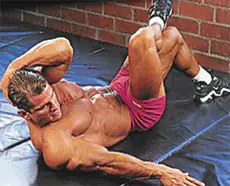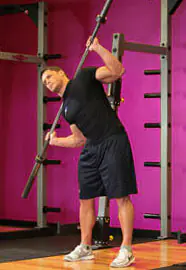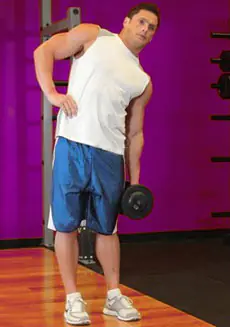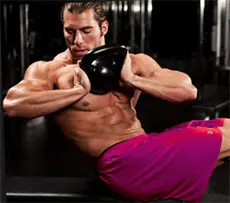Having strong core muscles, which include the external and internal obliques, makes it much easier to improve your results in any basic exercise. 
With moderate development, the lateral muscles of the torso ensure a toned figure, as well as the absence of any concerns related to the stability of the spine. At the moment, all effective variations of training for oblique abdomen come down to four elements:
- lateral bending with weights,
- standing body turns,
- bending sideways on a “Roman chair”,
- sit-ups and crunches with body rotation.
All other varieties (for example, tilts in a vertical block) do not have significant advantages.
So, below we will look in detail at the main exercises for the oblique abdominal muscles and focus your attention on the features of the technique and the anatomical nuances of their execution.

Standing body rotation. More suitable for warming up than pumping. You need to put a gymnastic stick on your shoulders (behind your head) and grab its ends, spreading your arms wider. Rotate your body left and right using isolated oblique force. Since the weight is insignificant, repetitions need to be done at least fifty, also with maximum amplitude. If you are a beginner, do not under any circumstances replace the stick with a barbell. If you really want to complicate your task, then it is better to use the upper block for this purpose. And you don’t need to turn your head while doing it: you are working on the waist area, not the vestibular apparatus. A popular alternative is body turns on the “Twist” simulator.
- Side bends with a dumbbell. Usually the muscles respond to bending of this kind so actively that most women would be better off abandoning them altogether, for the sake of maintaining a thin waist. You need to take the weight in one hand and place the other on your side. Slowly lean to the side with the weight where you have the weight, and then return to the starting position. In general, one phase of flexion or extension can take up to five seconds. The wider the legs, the easier it is to control the pelvis (it should be motionless). Do not lean back and forth, even if this will help make the lean deeper. And you don’t need to take a dumbbell in each hand - the resulting counterweight neutralizes all efforts. First, all approaches are performed for one side, and then ㅡ all the same for the opposite. In the next workout, the sides alternate in the reverse order. The option of bending over with a barbell on your shoulders is also common. Once you have decided, do not proceed until you have checked the security of both disk clamps. At home, such bends can be performed without weight, simply by clasping your straight arms above your head.

- Lateral bends on a Roman chair (through the “goat”). An effective but difficult exercise, which, however, can be further strengthened with a barbell disc. The weight is leaned against the chest or held behind the head. You need to secure your feet under the bolsters and adjust the height so that your upper body hangs freely. Bend your body strictly to the side, without lifting your torso above the horizontal.
- Sit ups and crunches with a twist. The starting position is the same as when training the rectus abdominis muscle: lying on your back, with your legs bent at pelvic width and your hands on the back of your head. As you exhale, lift your shoulder blades off the mat, and as you inhale, pause. Turn to the right (exhale), turn straight (inhale), turn to the opposite side (exhale). After five turns on each side, you can lower yourself to the floor: exhale and draw in your stomach more strongly.

To perform exercises for the obliques with the greatest impact, you need to understand some of the nuances of anatomy. The outer and inner abdominal muscle fibers run in opposite directions. As you turn your body, say, to the left, visualize the pull of the right side of your chest toward the center and left edge of your pelvis. And exactly the same for the opposite side - both halves of the body are involved in the movement as much as possible.
Just please don’t expect to get rid of fat around your waist using these recommendations! It has long been proven that local reduction of body fat through exercise is impossible. In this case, it is more likely that the waist circumference will increase. It is for this reason that girls are not recommended to start training their obliques at all! Although, if you exercise in a high-repetition mode and with light weights, this will not bring any catastrophic consequences, but rather the opposite. By strengthening our own muscle corset, we contribute, firstly, to the formation of a beautiful and fit posture. And secondly, when the lateral surfaces of the waist are toned, the relief of the rectus abdominis muscle is better drawn, that is, those same “cubes” desired by everyone.



